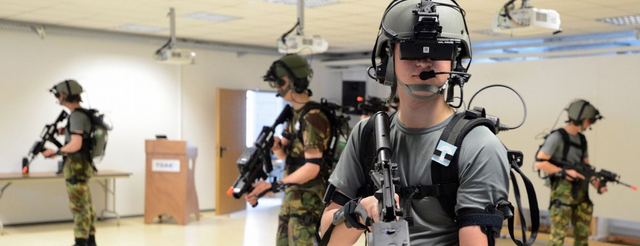Why The Military Loves Virtual Reality

If there is one way to guarantee that loads of money gets spent on the development of a new technology- it is to ensure that it has some potential military capability. You can bet, if it can have a use within the nation’s defenses or on the battle-field, the army, the navy and the air force will find room in their stretched budgets to shoehorn it in. And so it is with VR, though some of its uses may surprise you.
Equipment Simulations
As in any vehicle, the windows are the weakest link in an armoured vehicle- but, unfortunately, they are also quite useful for visibility too. In the past, the only way of eliminating that window-risk was via TV screens which were attached to cameras on the outside of the vehicle itself. 360 degree VR vision greatly improves on that and greatly improves of the efficacy of that vehicle in whatever situation it finds itself, along with the safety of its occupants.
Combat Simulations
Training or prepping for a combat situation can, of itself, be a dangerous proposition. The more realistic the situation, the more likely that someone could get hurt. In the Virtual Reality world, situations can be simulated to a far greater extent than they could be in the ‘real’ world with no risk to life or limb. Equally, those situations can easily be manipulated to train for slight changes in wind power or direction or an unexpected enemy incursion, for example. Until recently, combat simulations had been limited to ‘enhanced’ equipment simulation, but with the advent of the Dismounted Soldier Training System (DSTS), no one is getting away.
In Training
Virtual Reality is a great way of getting new recruits acclimatized, whether to a new environment or a completely different way of thinking and working. In the same way as during combat situations, different scenarios can be ‘modeled’, testing the recruits speed of thought, reaction and his ability to ‘think on his feet’. This can be tightly monitored because a trainer or superior office can see exactly what the trainee is looking, when and how he reacts. He is then able to intervene with guidance or instructions immediately, rather than during a run-through later. Of course, new recruits nowadays have been brought-up with a digital mindset, so it makes perfect sense to utilise that.
For PTSD
Since the dawn of warfare, the mental toll a combat situation takes on participants has been, largely, ignored. If a wound isn’t visible, then it isn’t there. It is only quite recently that PTSD has been recognized as a genuine condition and efforts made to repair damage caused. VR allows the viewer to become completely immersed in an environment. This allows for situations to be recreated offering a gradual re-acclimatisation for sufferers. More accurate and less mentally invasive than hypnotism, VR enables a step-by-step approach with the practitioner in minute control of exactly what the sufferer is seeing and reacting to.
Cost v Cost
It always seems a bit tacky to be talking about money when lives are at stake. But, the reality is, everything has a cost- and if it costs too much, then the money won’t get spent. The new Stryker simulator, for example, comes in at over half a million quid, but compared to the cost of the real thing, it’s a bargain. Anything that improves the efficiency of the guys handling all that expensive equipment ceases to be a cost and becomes a genuine investment that will make a return and save money. So, for Virtual Reality, the military is a perfect fit. It makes servicemen more effective, improves efficiency and saves a lot of cost- both in financial terms and human terms.
Originally Published at Maxbox VR: https://bit.ly/2MyRCUU
actually very good use cases for military and even saving money honestly. While it wont ever replace real world cases it can be used as a good tool for reflexes and training.